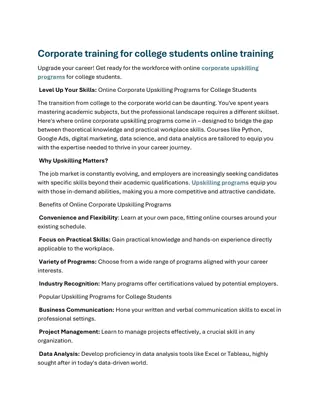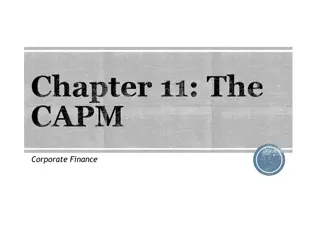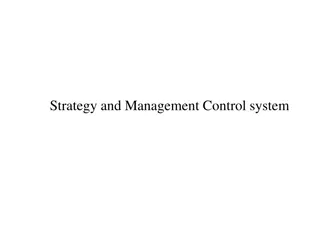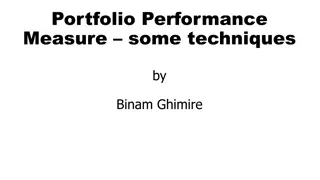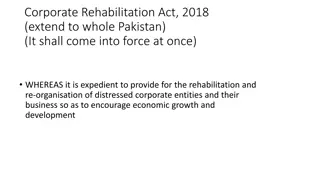Corporate Health Portfolio Challenges & Solutions Guide
This guide discusses the historical background, product features, pricing, and underwriting of corporate health portfolios in India. It explores challenges faced and offers probable solutions for improving the experience. Key topics include the evolution of employee health financing, corporate health plan offerings, and characteristics of corporate health portfolios.
Download Presentation

Please find below an Image/Link to download the presentation.
The content on the website is provided AS IS for your information and personal use only. It may not be sold, licensed, or shared on other websites without obtaining consent from the author.If you encounter any issues during the download, it is possible that the publisher has removed the file from their server.
You are allowed to download the files provided on this website for personal or commercial use, subject to the condition that they are used lawfully. All files are the property of their respective owners.
The content on the website is provided AS IS for your information and personal use only. It may not be sold, licensed, or shared on other websites without obtaining consent from the author.
E N D
Presentation Transcript
CORPORATE HEALTH PORTFOLIO: CHALLENGES & SOLUTIONS Guide: Mr. K.K. Dharni Date : 19 December 2014 Presenters: Ms. Vandana Baluni Mr. Irvinder Singh Kohli Mr. Abhijit Pal
Agenda 1 Historical background of Corporate Health 2 Corporate Health Product, Pricing & Underwriting 3 Corporate Health Indian Statistics 4 Probable reasons for Adverse Experience 5 Probable solutions 6 Conclusion 2
History Financing of employee health expenses, as a concept in India, was first put in place by the establishment of Employees State Insurance Corporation (ESIC) in 1948 . The act made it mandatory for blue collar workers to be covered by health insurance. Employees covered under the scheme are entitled to medical facilities for self and dependants. Cash benefits in the event of specified contingencies resulting in loss of wages or earning capacity were also provided under the scheme. Central Government introduced on 1st Jan 1954 the Central Government Health Scheme (CGHS) to provide healthcare benefits to the employees of central government. Voluntary health insurance for individuals and employees was introduced in 1987, by the launch of Mediclaim. 4
Corporate Health Plan Product, Pricing & Underwriting 5
Product Features of Corporate Health Products offered under Group Health are very flexible and comprehensive, which can be on either Individual or Family Floater basis providing coverage to spouse, children and parents of the main policyholder The product typically covers in-patient treatment, out-patient treatment, maternity cover etc with waivers of 30 days, 1or 2 year and pre-exiting waiting periods. Sub-limits are offered for benefits for different benefits offered in the product. Products are offered with wide range of sum insured from few thousands to over 10 lacs. Some products also offers Wellness schemes/programs along with these policies. Some products offer Corporate Buffer feature under which if sum insured of an employee is exhausted, he/she can use the amount from the Corporate Buffer, which is additional sum insured at policy level. Additional benefit such as Personal Accident, Critical Illness, Hospital Cash etc are also offered with these products. Cafeteria /Menu Type plan are offered which provide options to choice from range of benefits to Employee 6
Characteristics of Corporate Health Portfolios o Non-standard policy wordings and tailored products o Policy exclusions are often applied A Large Number of Products/Covers o A large number of different industries and occupations o Big variation in the occupation of the insured o Big variation in size of risk Heterogeneity o High proportion of large claims o Exposure to latent claims Volatility o Policies typically sold through Brokers/Agents who: o Want to reduce administrative costs o Try to limit inconvenience for their customers o Often provide bulk entered policies or claims o Lack of structured data data is often provided as free form text field. o Limitations of insurance system to record all relevant risk information Lack of Quantity and Quality of Data o Pricing is heavily influenced by the underwriting cycle o Relationship with intermediaries o Significant case underwriting o Individual policies may also have a material impact on GWP volumes and expense ratio A Large Number of Soft Factors 7
How is a Corporate Health Policy Priced? o A specified or book rate applied to exposure For some products this may be based on as few as one or two rating factors Others products may have a sophisticated pricing structure o Based on technical analysis of historic performance Technical Rate o A rate is calculated based on a burning cost of the insured s own claim experience o Assumptions are needed around: Inflation IBNR/IBNER Factors Large Loss Loadings Commissions / Expenses / Reinsurance / Profit Experience Rate o Underwriters may have the authority to apply loadings / discounts based on their own assessment of the risk o They may use information gathered from broker or other sources Underwriter Rate Final Rate o In practice a blend of methods will be used depending on the class of business / individual insured / underwriter judgment o For small or medium size of the policy the technical rate may used without further consideration Case underwriting is often uneconomic due to small average premium size o For a large commercial risk the rate may be based entirely on the insured s own experience There is no set rule for large , but there needs to be a meaningful claims pattern 8
Underwriting Guidelines of Corporate Health Products Underwriting guidelines for Corporate Health Products are normally very liberal. Fit to work criteria is generally acceptable to provide coverage to the employee. Generally no medical tests are conducted for underwriting (other than exceptional conditions for example very high sum insured, high sub-limits etc) Generally all employees (or specific level of employees) are covered in the policy. In case policy does not mandate coverage to all employee, then additional premium is charged to reduce anti-selection. 9
Business Statistics Health Insurance in India Growth of Health Insurance (GWP) Net Loss Ratio in Health Insurance 8 150% Premium (in thousand Cr) 7 125% 6 100% 5 Loss Ratio 4 75% 3 50% 2 25% 1 0 0% 2009 2010 2011 2012 2009 2010 2011 2012 Group Retail Group Retail Corporate Health insurance higher proportion of business as compared to Retail products. Loss Ratio for Corporate Health products are higher than Retail. Loss Ratio for Corporate Health products is improving in recent years. 11 Source IRDA Annual Reports Group refers to Corporate Health insurance.
Business Statistics Health Insurance in India Males have higher proportion of claim than Female for both Retail & Group Products. 26 35 age band has higher claim for Group products as compared to 36 45 for Retail products Female proportion in age band 16 25 & 26 35 have higher proportion of claim as compared to Male for Group product, which could be due to Maternity related claim. Maternity benefits have long waiting period in Retail products, hence the proportion of Female to Male claims are in similar proportion for Retail product. 12 Source IIB Health Report Group refers to Corporate Health insurance.
Probable reasons for Adverse Experience 1. Account underwriting 2. Benefit design & structure 3. Technical Pricing Approach not followed 4. Changes in demographic mix over the policy tenure (e.g.: growing companies) 5. Discounts structure 6. Role of intermediary 7. Claim Management 14 Contd ..
Probable reasons for Adverse Experience Account underwriting Corporate Health insurance was historically offered free or subsidized rate as part of the commercial insurance coverage such as commercial coverage Fire, Theft etc. Premium for commercial coverage was based on standard tariff, hence Corporate Health was offered free to offer discount or better overall premium to corporates. Commercial coverage were profitable, hence high loss ratio due Corporate Health had minimal impact as absolute size was small. Insurance Companies were not focusing on Health Insurance business, hence performance of Corporate Health was not tracked. Benefit design & structure High sum insured offered to selected employees (company directors, CXO s) without adequate underwriting. Pre-existing coverage to higher ages (parents) with limited underwriting. High utilization for certain benefits (for example Out-patient coverage) 15 Contd ..
Probable reasons for Adverse Experience Comparison of Loss Ratio (Retail Health) Comparison of Loss Ratio (Corporate Health) 150% 150% 125% 125% 100% 100% Loss Ratio Loss Ratio 75% 75% 50% 50% 25% 25% 0% 0% 2009 2010 2011 2012 2009 2010 2011 Private 2012 Public Public Private Technical Pricing Approach not followed Technical Pricing is used for Retail health products, hence have better experience for both Public & Private Health insurance companies. Lack of credible data for technical pricing. Lack of expertise for pricing Limited experience of the insurer/ industry Market is too competitive, insurer fear to loose business due to high premium, which might be suggested by technical pricing approach. Discounts offered by companies due to commercial reason 16 Source IRDA Annual Reports Contd ..
Probable reasons for Adverse Experience Changes in demographic mix over the policy tenure Demographic mix may change for small or medium companies (large hiring or attrition), leads to experience rated premium to representative of the experience. Significant decrease in number of lives covered in the policy, leads to higher proportion of refund of premium. Discount structures The discount structures are often discretionary and decision is taken by underwriters based on their understanding of the business, which is subjective. Lack of objectivity often leads to insurers offering heavy discounts due to competitive pressure. 17 Contd ..
Probable reasons for Adverse Experience Intermediary Intermediary is more close to Employer and provides other services, hence has access to more information which it may or may not be shared with insurer. Intermediary provides data for pricing and which is not of high quality. Intermediaries may influence the premium to be charged and are more focused to get the business. Intermediary may not provide complete information to all insurer, leading to experience rating not credible for insurer with lack of information. Claim Management Higher than expected utilization of the benefits due to change in management practices. Claim settlement by TPA, who may focus on meeting turnaround time rather claim amount. Lack on focus by insurer in earlier years. Adequate data not collected by insurer, which leads to lack of information for pricing. 18 Contd ..
Probable Solutions 1. Data for Pricing 2. Pricing Approach 3. Industry wide initiatives 4. Product and Benefit structures 5. Focus on Service 6. Focus from Regulator 7. Non-traditional arrangement 8. Reinsurance 9. Focus on wellness and preventive 20
Probable Solutions Data for Pricing Improve Quality of data standardized format agreed by industry 2 to 3 year of data used for pricing Minimum data requirement to provide the quote Insurer, intermediary, employer etc to understand importance of data Pricing Approach Involve actuaries for large cases Check adequacy of premium for the policy Analyze experience at more granular level to help understand the challenges better. Assumptions on medical and expense inflation Book rates can be used for small/medium groups Industry-wide initiatives Industry participants must come together to improve the experience Reduce undercutting of premium to get the business Operational efficiencies to reduce expense and increase margins Adequate training to employees/sales channel so that appropriate information is collected. Expense rationalization e.g. TPA fees linked to profitability and service level., technological advances etc. Standardize data format and requirement to provide the quote. 21 Contd ..
Probable Solutions Product & Benefit Structures Offer restrictive products Limit on maternity claims Deductible/excess for high utilization benefits High sum insured not offered to small groups Minimum group size to offer Corporate Health coverage Focus on Service Active claim management Seamless enrollment of the employees Improve efficiencies in processes Real-time information available to Employer Focus from Regulator Approval of Premium / Product Reporting of experience by insurance companies Control in Broker/Agents Control in level of flexibility allowed in products Monitoring of claim experience of Corporate Health business to ensure that adequate premium is charged 22 Contd ..
Probable Solutions Non-traditional Arrangements Profit sharing arrangement between Insurance company & Employer Stop-loss arrangement Sharing of policy between more than one insurance company. Cost sharing arrangements Reinsurance Reinsurance arrangements for large groups Portfolio level reinsurance arrangement may deter insurer on undercutting premium Will help in improving capturing of data Provide guidance to insurer on writing large risk Wellness & Preventive Care Helps in improving overall health of the lives covered Adds value to the policy Allows closer interaction with the employees and helps in better understanding their issues 23 Contd ..
Conclusion 24
Conclusion Claims experience for the Corporate Health portfolio is improving over year. Data is an important factor in estimation of correct premium. Increased used of technology & industry-wide commitment can help in improving data quality. Regulator has increased the focus on the Corporate Health products, which is a welcome move in this direction. Increased use of technology in the areas of data collection, enrollment,, underwriting and claim management can reduce the information asymmetry between insurers. The employers & employees must be incentivized for having better claim experience and data management. Addition of Value Added Services (e.g. Wellness) will not only increase the size of the premium but also improve the health of the covered lives over long run. 25
Thank you!! 26






